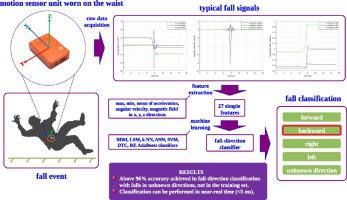Digital Signal Processing ( IF 2.9 ) Pub Date : 2021-06-07 , DOI: 10.1016/j.dsp.2021.103129 Mustafa Şahin Turan , Billur Barshan

|
Effective fall-detection and classification systems are vital in mitigating severe medical and economical consequences of falls to people in the fall risk groups. One class of such systems is based on wearable sensors. While there is a vast amount of academic work on this class of systems, the literature still lacks effective and robust algorithms and comparative evaluation of state-of-the-art algorithms on a common basis, using a sufficiently large dataset. In this article, fall-direction classification algorithms are presented and compared on an extensive dataset, comprising a total of 1600 fall trials. Eight machine learning classifiers are implemented for fall-direction classification into four basic directions (forward, backward, right, and left). These are, namely, Bayesian decision making (BDM), least squares method (LSM), k-nearest neighbor classifier (k-NN), artificial neural networks (ANNs), support vector machines (SVMs), decision-tree classifier (DTC), random forest (RF), and adaptive boosting/AdaBoost (AB). BDM achieves perfect classification, followed by k-NN, SVM, and RF. Data acquired from only a single motion sensor unit, worn at the waist of the subject, are processed for experimental verification. Four of the classifiers (BDM, LSM, k-NN, and ANN) are modified to handle the presence of data from an unknown class and evaluated on the same dataset. In this robustness analysis, ANN and k-NN yield accuracies above 96.2%. The results obtained in this study are promising in developing real-world fall-classification systems as they enable fast and reliable classification of fall directions.
中文翻译:

通过可穿戴运动传感器对坠落方向进行分类
有效的跌倒检测和分类系统对于减轻跌倒对跌倒风险人群造成的严重医疗和经济后果至关重要。一类这样的系统基于可穿戴传感器。虽然在这类系统上有大量的学术工作,但文献仍然缺乏有效和稳健的算法以及使用足够大的数据集在共同基础上对最先进算法的比较评估。在本文中,介绍了跌倒方向分类算法并在一个广泛的数据集上进行了比较,该数据集包括总共 1600 次跌倒试验。实现了八个机器学习分类器,用于将下降方向分类为四个基本方向(向前、向后、向右和向左)。它们是,即贝叶斯决策(BDM)、最小二乘法(LSM)、k -最近邻分类器 ( k -NN)、人工神经网络 (ANN)、支持向量机 (SVM)、决策树分类器 (DTC)、随机森林 (RF) 和自适应增强/AdaBoost (AB)。BDM 实现了完美的分类,其次是k- NN、SVM 和 RF。仅从佩戴在受试者腰部的单个运动传感器单元获取的数据进行处理以进行实验验证。修改了四个分类器(BDM、LSM、k -NN 和 ANN)以处理来自未知类的数据的存在并在同一数据集上进行评估。在这个稳健性分析中,ANN 和k-NN 产率精度高于 96.2%。本研究中获得的结果在开发真实世界的跌倒分类系统方面很有前景,因为它们能够快速可靠地对跌倒方向进行分类。











































 京公网安备 11010802027423号
京公网安备 11010802027423号